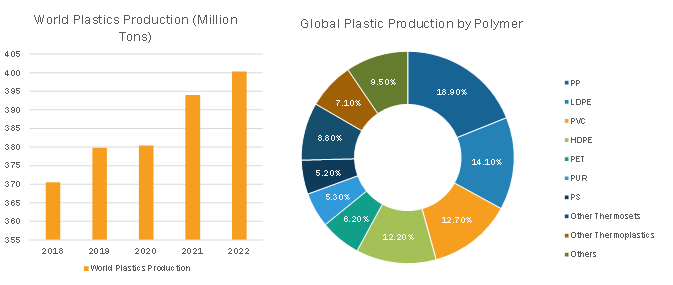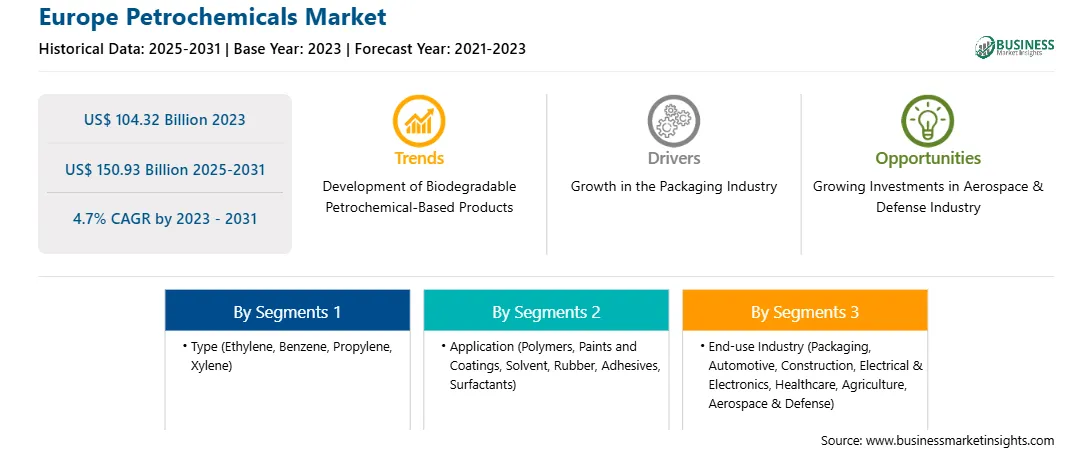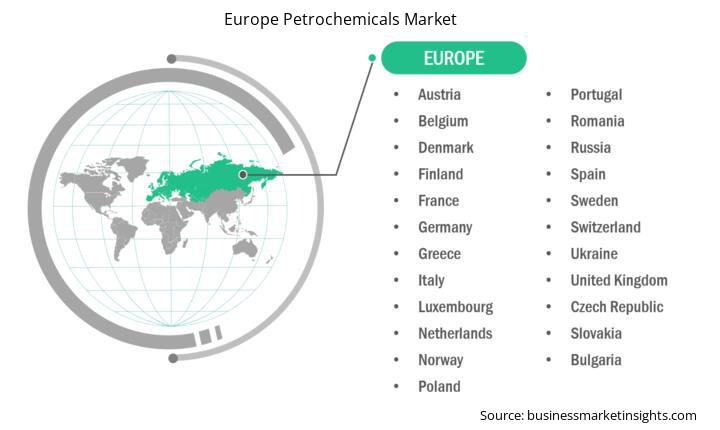The Europe petrochemicals market was valued at US$ 104.32 billion in 2023 and is expected to reach US$ 150.93 billion by 2031; it is estimated to record a CAGR of 4.7% from 2023 to 2031.
Petrochemical-based polymers such as polyamide, polypropylene, polystyrene, high-density polyethylene, thermoplastic elastomers, polyurethane, polycarbonate, and polyvinyl chloride are widely used in the automotive industry as these polymers offer excellent durability and resistance to corrosion. According to the CDI Products Company, the automotive industry is a significant consumer of polymers. These polymers enhance the longevity of automotive components, including interior parts and exterior body panels, as well as under-the-hood applications. As per the Plastics Europe 2023 report, the global production of plastics increased from 380.4 million tons in 2020 to 400.3 million tons in 2022.
Strategic insights for the Europe Petrochemicals provides data-driven analysis of the industry landscape, including current trends, key players, and regional nuances. These insights offer actionable recommendations, enabling readers to differentiate themselves from competitors by identifying untapped segments or developing unique value propositions. Leveraging data analytics, these insights help industry players anticipate the market shifts, whether investors, manufacturers, or other stakeholders. A future-oriented perspective is essential, helping stakeholders anticipate market shifts and position themselves for long-term success in this dynamic region. Ultimately, effective strategic insights empower readers to make informed decisions that drive profitability and achieve their business objectives within the market. The geographic scope of the Europe Petrochemicals refers to the specific areas in which a business operates and competes. Understanding local distinctions, such as diverse consumer preferences (e.g., demand for specific plug types or battery backup durations), varying economic conditions, and regulatory environments, is crucial for tailoring strategies to specific markets. Businesses can expand their reach by identifying underserved areas or adapting their offerings to meet local demands. A clear market focus allows for more effective resource allocation, targeted marketing campaigns, and better positioning against local competitors, ultimately driving growth in those targeted areas.
Europe Petrochemicals Strategic Insights

Europe Petrochemicals Report Scope
Report Attribute
Details
Market size in 2023
US$ 104.32 Billion
Market Size by 2031
US$ 150.93 Billion
CAGR (2023 - 2031) 4.7%
Historical Data
2021-2023
Forecast period
2025-2031
Segments Covered
By Type
By Application
By End-use Industry
Regions and Countries Covered
Europe
Market leaders and key company profiles
Europe Petrochemicals Regional Insights

According to the CDI Products Company, the automotive industry has various applications of petrochemical-based polymers, including PTFE seals, O-rings, bearings and thrust bearings, low-drag mudflaps, suspension cylinder seals, sensor covers, diaphragms, rotary seals, custom-made gaskets, wiring harnesses & housing, and battery sealing for pressure valves, among others. The EU registered the production of more than 9 million cars in the first three quarters of 2023, a rise of 14% from the same quarter in 2022, as per the European Automobile Manufacturers' Association. The growing utilization of polymers in the automotive industry, coupled with the developments in the automotive industry, fuels the demand for petrochemicals.
Polymers are used in construction for insulation, windows, pipes, and coatings due to their energy-efficient properties. They help reduce energy consumption in buildings by providing effective thermal insulation. With the rise in construction activities, the demand for petrochemical-based materials is also increasing. Thus, the rising demand for polymers across various end-use industries fuels the petrochemicals market growth.
Europe Petrochemicals Market Overview
Germany is one of the leading producers of automobiles in the world, and several major car manufacturing companies, including Volkswagen, BMW AG, and Audi, are located in the country. Germany produces ~6 million vehicles annually, including passenger cars and commercial vehicles. According to Germany Trade & Invest GmbH, Germany is Europe's largest automotive market, with strong production and sales, accounting for ~25% of all passenger cars manufactured and almost 20% of all new registrations. The country also possesses the largest concentration of original equipment manufacturer (OEM) plants in Europe. With 44 OEM sites located in Germany, the country's OEM market share in the European Union was more than 55% in 2021. The automotive industry, a cornerstone of Germany's economy, relies heavily on petrochemical products. Petrochemicals are essential in producing various automotive components such as plastics for interiors, synthetic rubber for tires, and polymers for lightweight, fuel-efficient parts. As German automakers continually innovate to produce efficient and lightweight vehicles, the demand for specialized petrochemicals remains high.
Moreover, the pharmaceutical and healthcare sectors in Germany contribute to the demand for petrochemicals. The country is a leader in pharmaceutical production, and petrochemical derivatives are critical in manufacturing drugs, medical devices, and packaging materials. The demand for high-quality plastics and polymers that meet stringent health and safety standards is high, supporting the production of syringes, IV bags, and other medical supplies.
Europe Petrochemicals Market Revenue and Forecast to 2031 (US$ Billion)
Strategic insights for the Europe Petrochemicals provides data-driven analysis of the industry landscape, including current trends, key players, and regional nuances. These insights offer actionable recommendations, enabling readers to differentiate themselves from competitors by identifying untapped segments or developing unique value propositions. Leveraging data analytics, these insights help industry players anticipate the market shifts, whether investors, manufacturers, or other stakeholders. A future-oriented perspective is essential, helping stakeholders anticipate market shifts and position themselves for long-term success in this dynamic region. Ultimately, effective strategic insights empower readers to make informed decisions that drive profitability and achieve their business objectives within the market.

| Report Attribute | Details |
|---|---|
| Market size in 2023 | US$ 104.32 Billion |
| Market Size by 2031 | US$ 150.93 Billion |
| CAGR (2023 - 2031) | 4.7% |
| Historical Data | 2021-2023 |
| Forecast period | 2025-2031 |
| Segments Covered |
By Type
|
| Regions and Countries Covered | Europe
|
| Market leaders and key company profiles |
|
The geographic scope of the Europe Petrochemicals refers to the specific areas in which a business operates and competes. Understanding local distinctions, such as diverse consumer preferences (e.g., demand for specific plug types or battery backup durations), varying economic conditions, and regulatory environments, is crucial for tailoring strategies to specific markets. Businesses can expand their reach by identifying underserved areas or adapting their offerings to meet local demands. A clear market focus allows for more effective resource allocation, targeted marketing campaigns, and better positioning against local competitors, ultimately driving growth in those targeted areas.

Europe Petrochemicals Market Segmentation
The Europe petrochemicals market is segmented based on type, application, end-use industry, and country. Based on type, the Europe petrochemicals market is segmented into ethylene, benzene, propylene, xylene, and others. The ethylene segment held the largest market share in 2023.
In terms of application, the Europe petrochemicals market is segmented into polymers, paints and coatings, solvent, rubber, adhesives, surfactants, and others. The polymers segment held the largest market share in 2023.
By end-use industry, the Europe petrochemicals market is categorized into packaging, automotive, construction, electrical & electronics, healthcare, agriculture, aerospace & defense, and others. The packaging segment held the largest market share in 2023.
Based on country, the Europe petrochemicals market is segmented into Germany, France, Italy, the UK, Russia, and the Rest of Europe. The Rest of Europe dominated the Europe petrochemicals market share in 2023.
Shell Plc, LyondellBasell Industries NV, Saudi Basic Industries Corp, BASF SE, INEOS Group Holdings SA, Dow Inc, Chevron Phillips Chemical Company LLC, China Petroleum & Chemical Corp, Mitsubishi Chemical Group Corp, and Exxon Mobil Corp are some of the leading players operating in the Europe petrochemicals market.
The Europe Petrochemicals Market is valued at US$ 104.32 Billion in 2023, it is projected to reach US$ 150.93 Billion by 2031.
As per our report Europe Petrochemicals Market, the market size is valued at US$ 104.32 Billion in 2023, projecting it to reach US$ 150.93 Billion by 2031. This translates to a CAGR of approximately 4.7% during the forecast period.
The Europe Petrochemicals Market report typically cover these key segments-
The historic period, base year, and forecast period can vary slightly depending on the specific market research report. However, for the Europe Petrochemicals Market report:
The Europe Petrochemicals Market is populated by several key players, each contributing to its growth and innovation. Some of the major players include:
The Europe Petrochemicals Market report is valuable for diverse stakeholders, including:
Essentially, anyone involved in or considering involvement in the Europe Petrochemicals Market value chain can benefit from the information contained in a comprehensive market report.